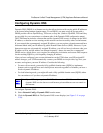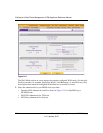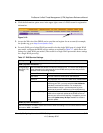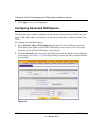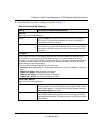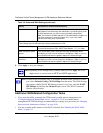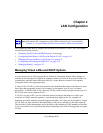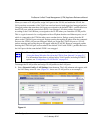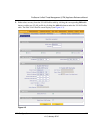
ProSecure Unified Threat Management (UTM) Appliance Reference Manual
4-2 LAN Configuration
v1.0, January 2010
VLANs have a number of advantages:
• It is easy to set up network segmentation. Users who communicate most frequently with each
other can be grouped into common VLANs, regardless of physical location. Each group’s
traffic is contained largely within the VLAN, reducing extraneous traffic and improving the
efficiency of the whole network.
• They are easy to manage. The addition of nodes, as well as moves and other changes, can be
dealt with quickly and conveniently from a management interface rather than from the wiring
closet.
• They provide increased performance. VLANs free up bandwidth by limiting node-to-node and
broadcast traffic throughout the network.
• They ensure enhanced network security. VLANs create virtual boundaries that can be crossed
only through a router. So standard, router-based security measures can be used to restrict
access to each VLAN.
Managing the UTM’s Port-Based VLANs
The UTM supports port-based VLANs. Port-based VLANs help to confine broadcast traffic to the
LAN ports. Even though a LAN port can be a member of more than one VLAN, the port can have
only one VLAN ID as its Port VLAN Identifier (PVID). By default, all four LAN ports of the
UTM are assigned to the default VLAN, or VLAN 1. Therefore, by default, all four LAN ports
have default PVID 1. However, you can assign another PVID to a LAN port by selecting a VLAN
profile from the pull-down menu on the LAN Setup screen.
After you have created a VLAN profile and assigned one or more ports to the profile, you must
first enable the profile to activate it.
The UTM’s default VLAN cannot be deleted. All untagged traffic is routed through the default
VLAN (VLAN1), which must be assigned to at least one LAN port.
Note the following about VLANs and PVIDs:
• One physical port is assigned to at least one VLAN.
• One physical port can be assigned to multiple VLANs.
• When one port is assigned to multiple VLAN, the port is used as a trunk port to connect to
another switch or router.
• When a port receives an untagged packet, this packet is forwarded to a VLAN based on the
PVID.
• When a port receives a tagged packet, this packet is forwarded to a VLAN based on the ID that
is extracted from the tagged packet.




